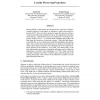118
Voted
NIPS
2003
15 years 2 months ago
2003
We propose a method for sequential Bayesian kernel regression. As is the case for the popular Relevance Vector Machine (RVM) [10, 11], the method automatically identifies the num...
69
Voted
NIPS
2003
15 years 2 months ago
2003
The 2-class transduction problem, as formulated by Vapnik [1], involves finding a separating hyperplane for a labelled data set that is also maximally distant from a given set of...
108
click to vote
NIPS
2003
15 years 2 months ago
2003
Many problems in information processing involve some form of dimensionality reduction. In this paper, we introduce Locality Preserving Projections (LPP). These are linear projecti...
124
click to vote
WSCG
2004
15 years 2 months ago
2004
Several sophisticated methods are available for efficient rendering of out-of-core terrain data sets. For huge data sets the use of preprocessed tiles has proven to be more effici...
96
Voted
WSCG
2004
15 years 2 months ago
2004
In many application domains, data is collected and referenced by its geo-spatial location. Spatial data mining, or the discovery of interesting patterns in such databases, is an i...
110
Voted
WSCG
2004
15 years 2 months ago
2004
Virtual and Augmented Reality allows a new way of result exploration of numerical simulations, its analysis and interpretation by immersing the user into the data sets and/or by k...
102
Voted
WSC
2004
15 years 2 months ago
2004
Using simulated data to develop and study diagnostic tools for data analysis is very beneficial. The user can gain insight about what happens when assumptions are violated since t...
72
Voted
WSCG
2001
15 years 2 months ago
2001
We propose volume registration procedures based on spherical artificial markers presented in medical multimodal data sets (MRI and CT, especially). The procedures proposed are eit...
130
Voted
WOB
2004
15 years 2 months ago
2004
Several advanced techniques have been proposed for data clustering and many of them have been applied to gene expression data, with partial success. The high dimensionality and the...
122
click to vote
VMV
2004
15 years 2 months ago
2004
Visualizing iso-surfaces of volumetric data sets is becoming increasingly important for many practical applications. One crucial task in iso-surface ray tracing is to find the cor...




